Dunrobin Castle is a stately home in Sutherland, in the Highland...
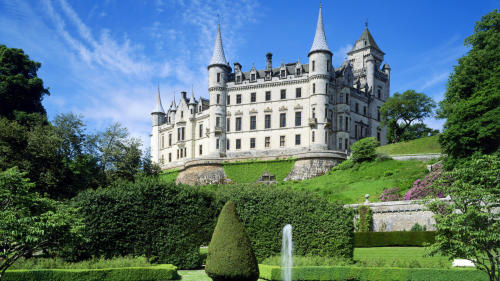
Dunrobin Castle is a stately home in Sutherland, in the Highland area of Scotland. It is the seat of the Countess of Sutherland and the Clan Sutherland. Nearby Dunrobin Castle railway station, on the Far North Line was originally a private station for the castle. Dunrobin's origins lie in the Middle Ages, but most of the present building is the work of Sir Charles Barry, the architect of the Palace of Westminster in London, who greatly extended the building in 1845. The resulting house has a "French Renaissance meets Scots Baronial" style. Some of the original building is visible in the interior courtyard. (wiki)
Chateau de Martainville was built by Jacques Le Pelletier...
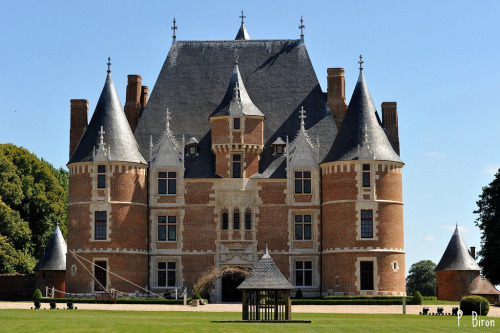
Chateau de Martainville was built by Jacques Le Pelletier starting in 1481, embellishing the existiong Martainville Stronghold, which was originally a castle with four towers and a bridge.
Since 1962, the chateau has housed the Museum of Arts and Traditions Normans and its rich collections, including furniture XV Regional nineteenth centuries, jewelry, ceramics, glass, costumes or objects of everyday life.
The Fort de Joux or Château de Joux is a castle, transformed...
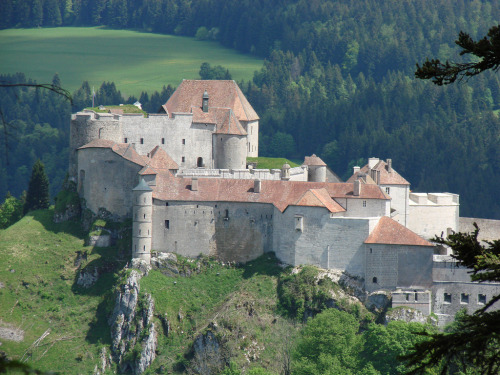
The Fort de Joux or Château de Joux is a castle, transformed into a fort, located in La Cluse-et-Mijoux, in the Doubs département, in the Jura mountains of France. It commands the mountain pass "Cluse de Pontarlier".
During its long history, Fort de Joux has gone through successive transformations. The first structure, in the 11th century, was made of wood. In the next century the lords of Joux rebuilt it in stone. It passed, along with all of Franche-Comté, into the hands of Burgundy, and then the Hapsburgs and the Spanish. It was finally regained for France in 1687 by Louis XIV.
While others have improved or at least repaired the castle during the course of its history, Fort de Joux's most famous remodeler was Vauban, who modernized it in 1690. The Austrians captured it in 1814. Later, the construction of the forts at Larmont during the 19th century provided reinforcement. In 1879, Captain (later General) Joffre, then a military engineering officer, modernised it and transformed it into a fort. (wiki)
The current Chateau Briantais was built on the site of a 17th...
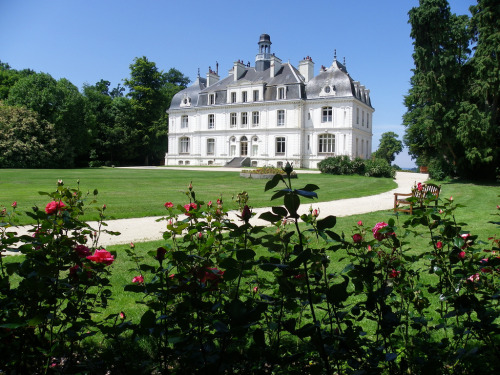
The current Chateau Briantais was built on the site of a 17th century mansion that was already using that name. It belonged to one of the largest ship owning families Malo, then became the property of the family in 1888 with The Chamber Guy La Chambre, former state minister, MP and Mayor of the city of Saint-Malo. Chateau Briantais is now owned by the city of Saint-Malo, France. Many cultural events are data, jazz, classical music, art exhibitions. The flower market of Saint-Malo takes place in the chateau grounds each May.
The construction of Chateau de Beaumesnil was initiated in 1633...
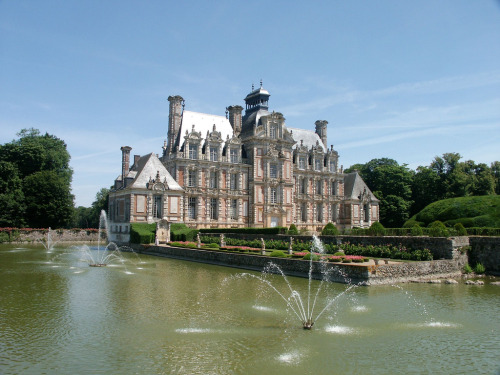
The construction of Chateau de Beaumesnil was initiated in 1633 by Jacques, Marquess of Nonant, for his wife Marie Dauvet Desmaret on the remains of a stronghold of which the dungeon surrounded by moats is now covered by box trees, Beaumesnil was completed in 1640.
Beaumesnil is a very rare example of Louis XIII architecture between baroque and manierist style. This originality comes from its monumental chimneys, and all kind of optical effects and ornaments.
Chateau do Fourchaud is located in Besson, Allier, France. The...
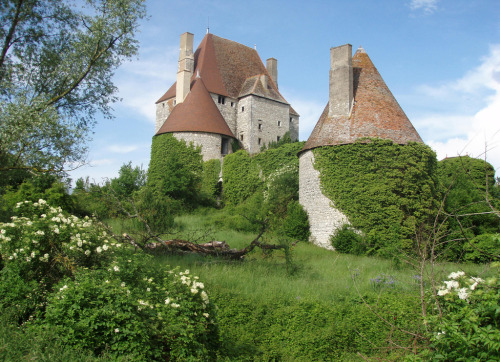
Chateau do Fourchaud is located in Besson, Allier, France. The name seems to come from Fourchaud "fork" since this is where the Gallo-Roman road split to Bourges and Lyon and Clermont-Ferrand. The first traces of the castle date back to 1351, when Jean Mareschal made claim of his land and his castle.
Kilkenny Castle is a castle in Kilkenny, Ireland built in 1195...
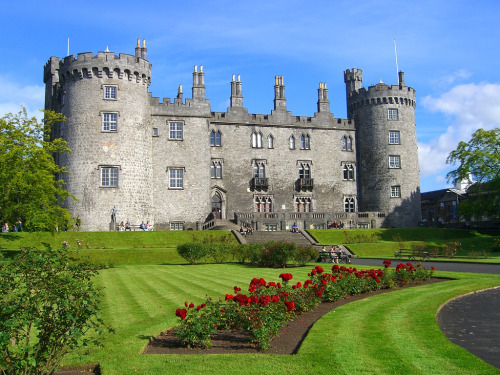
Kilkenny Castle is a castle in Kilkenny, Ireland built in 1195 by William Marshal, 1st Earl of Pembroke to control a fording-point of the River Nore and the junction of several roads. It was a symbol of Norman occupation and in its original thirteenth-century condition it would have formed an important element of the defenses of the town with four large circular corner towers and a massive ditch, part of which can still be seen today on the Parade. (wiki)
The first Chateau which was situated on ancient land of The...
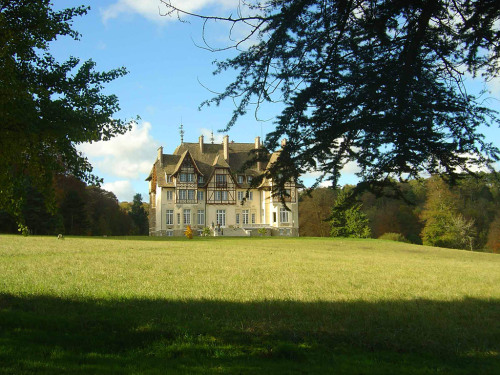
The first Chateau which was situated on ancient land of The Middle Ages was that of the Petimus, and was situated just below the actual Chateau of today. One of its first known owners was Francois de l'Hopital in 1620. The only remaining witness that of those past centuries is the Chapel, which was constructed by Claude Le Picard in 1670, to be used as a private burial place.
In 1887, le prince Joachim Murat (5th of the name) who was married to Cécile Ney d'Echingen (the great-granddaughter of Maréchal Ney) bought the property off of Baron Camont de Valence and Marie de Beaumont. They had the original Chateau destroyed to make way for a new one, which was constructed just next to the ruins of its predecessor by the architects Blondel and Langlois. The English style park was designed by landscape gardener Duchene with a view to create a romantic landscape. Numerous craftsmen from Chambly contributed to its creation.
The estate's connection with the Montmorency family began...
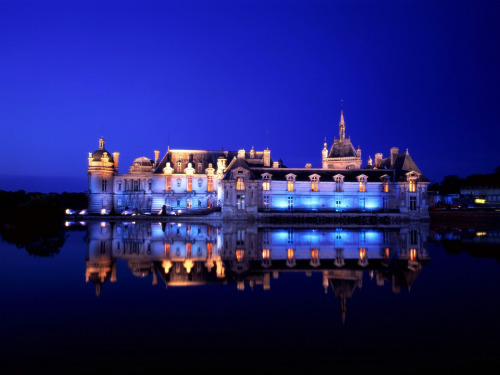
The estate's connection with the Montmorency family began in 1484. The first mansion (no longer extant, now replaced by the Grand Château) was built in 1528–1531 for the Constable Anne de Montmorency by Pierre Chambiges. The Petit Château was also built for him, around 1560, probably by Jean Bullant. In 1632, after the death of Henri II, it passed to the Grand Condé who inherited it through his mother, a de Gre-Montmorency.
The original mansion was destroyed in the French Revolution. It was repaired in a modest way by the last Condé, but the entire property was confiscated from the Orléans family between the years 1853 and 1872, during which interval it was owned by Coutts, an English bank. Chantilly was entirely rebuilt in 1875–1881 by Henri d'Orléans, duc d'Aumale (1822–1897) to the designs of Honore Daumet. The new château met with mixed reviews. Boni de Castellane summed up one line of thought: "What is today styled a marvel is one of the saddest specimens of the architecture of our era — one enters at the second floor and descends to the salons". In the end, the Duc d'Aumale bequeathed the property to the Institut de France upon his death in 1897. (wiki)
The Château d'Ancy-le-Franc, designed by Sebastiano Serlio...
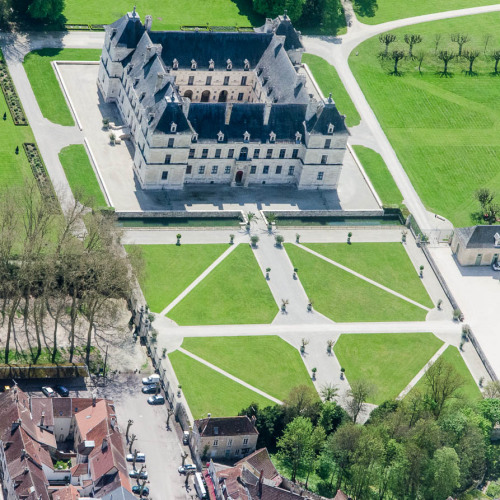
The Château d'Ancy-le-Franc, designed by Sebastiano Serlio and constructed 1544-1550, is one of the sites where the Italian Renaissance was introduced, full-blown, to France. The patron was Antoine de Clermont, comte de Tonnerre, the brother-in-law of Diane de Poitiers and a courtier of François I. (wiki)
The Château de Foix is a castle which dominates the town of Foix...
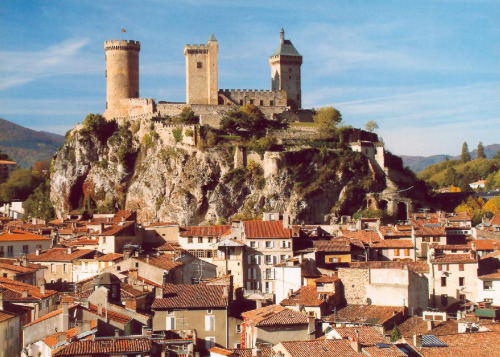
The Château de Foix is a castle which dominates the town of Foix in the French département of Ariège.
Built on an older 7th century fortification, the castle is known from 987. In 1002, it was mentioned in the will of Roger I, Count of Carcassonne, who bequeathed the fortress to his youngest child, Bernard. In effect, the family ruling over the region were installed here which allowed them to control access to the upper Ariège valley and to keep surveillance from this strategic point over the lower land, protected behind impregnable walls.
In 1034, the castle became capital of the County of Foix and played a decisive role in mediaeval military history. During the two following centuries, the castle was home to Counts with shining personalities who became the soul of the Occitan resistance during the crusade against the Albigensians. The county became a privileged refuge for persecuted Cathars.
The castle, often besieged (notably by Simon de Montfort in 1211 and 1212), resisted assault and was only taken once, in 1486, thanks to treachery during the war between two branches of the Foix family.
From the 14th century, the Counts of Foix spent less and less time in the uncomfortable castle, preferring the Governors' Palace (Palais des gouverneurs). From 1479, the Counts of Foix became Kings of Navarre and the last of them, made Henri IV of France, annexed his Pyrrenean lands to France.
As seat of the Governor of the Foix region from the 15th century, the castle continued to ensure the defence of the area, notably during the Wars of Religion. Alone of all the castles in the region, it was exempted from the destruction orders of Richelieu (1632-1638).
Until the Revolution, the fortress remained a garrison. Its life was brightened with grand receptions for its governors, including the Count of Tréville, captain of musketeers under Louis XIII and Marshal Philippe Henri de Ségur, one of Louis XVI's ministers. The Round Tower, built in the 15th century, is the most recent, the two square towers having been built before the 11th century. They served as a political and civil prison for four centuries until 1862. (wiki)
The Château de Villandry is a castle-palace located in...

The Château de Villandry is a castle-palace located in Villandry, in the département of Indre-et-Loire, France.
The lands where an ancient fortress once stood were known as Colombier until the 17th century. Acquired in the early 16th century by Jean Le Breton, France's Controller-General for War under King Francis I, a new château was constructed around the original 14th-century keep where King Philip II of France once met Richard I of England to discuss peace. It is also known for its beautiful gardens.
The château remained in the Le Breton family for more than two centuries until it was acquired by the Marquis de Castellane. During the French Revolution the property was confiscated and in the early 19th century, Emperor Napoleon acquired it for his brother Joseph Bonaparte.
In 1906, Joachim Carvallo purchased the property and poured an enormous amount of time, money and devotion into repairing it and creating what many consider to be the most beautiful gardens anywhere. Its famous Renaissance gardens include a water garden, ornamental flower gardens, and vegetable gardens. The gardens are laid out in formal patterns created with low box hedges. In 1934, Château de Villandry was designated a Monument historique. Like all the other châteaux of the Loire Valley, it is a World Heritage Site.
Still owned by the Carvallo family, the Château de Villandry is open to the public and is one of the most visited châteaux in France; in 2007 the château received about 330,000 visitors. (wiki)
Château Pichon Longueville Baron is a winery in the Pauillac...
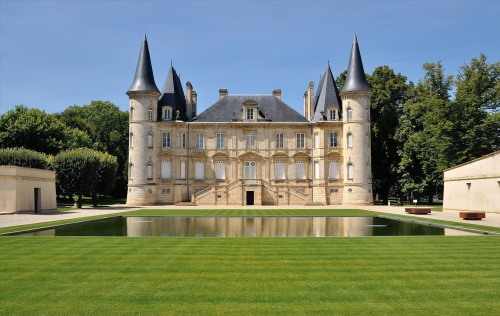
Château Pichon Longueville Baron is a winery in the Pauillac appellation of the Bordeaux region of France. Château Pichon Longueville Baron is also the name of the red wine produced by this property. Château Pichon Baron was once part of a larger estate, owned by Pierre de Rauzan, along with Château Pichon Longueville Comtesse de Lalande. In 1850 the estate was divided into the two current Pichon estates.
Château d'Ussé is located in the commune of Rigny-Ussé in...
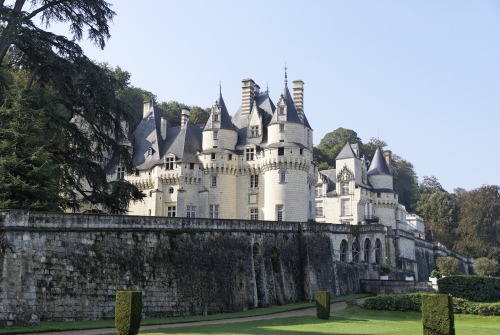
Château d'Ussé is located in the commune of Rigny-Ussé in the Indre-et-Loire département, in France. The stronghold at the edge of the Chinon forest overlooking the Indre Valley was first fortified in the eleventh century by the Norman seigneur of Ussé, Gueldin de Saumur, who surrounded the fort with a palisade on a high terrace. The site passed to the Comte de Blois, who rebuilt in stone.
In the fifteenth century, the ruined castle of Ussé was purchased by Jean V de Bueil, a captain-general of Charles VII who became seigneur of Ussé in 1431 and began rebuilding it in the 1440s; his son Antoine de Bueil married in 1462 Jeanne de Valois, the biological daughter of Charles VII and Agnès Sorel, who brought as dowry 40000 golden écus. Antoine was heavily in debt and in 1455, sold the château to Jacques d'Espinay, son of a chamberlain to the Duke of Brittany and himself chamberlain to the king; Espinay built the chapel, completed by his son Charles in 1612, in which the Flamboyant Gothic style is mixed with new Renaissance motifs, and began the process of rebuilding the fifteenth-century château that resulted in the sixteenth-seventeenth century aspect of the structure to be seen today.
In the seventeenth century Louis I de Valentinay, comptroller of the royal household, demolished the north range of buildings in order to open the interior court to the spectacular view over the parterre terrace, to a design ascribed to André Le Nôtre. (wiki)
Thornton Manor is a large house in the village of Thornton...
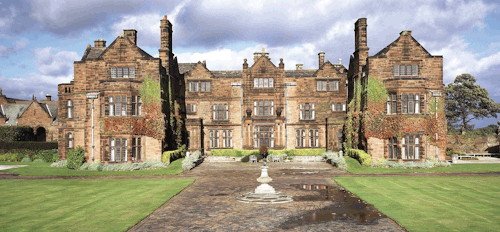
Thornton Manor is a large house in the village of Thornton Hough, Wirral, Merseyside, England. It has been designated by English Heritage as a Grade II listed building. The house was first built in the middle of the 19th century and has been altered and extended in a number of phases since. From 1888 to the end of the 20th century the house was occupied by the Viscounts Leverhulme.
Schweriner Schloss is a castle located in the city of Schwerin,...
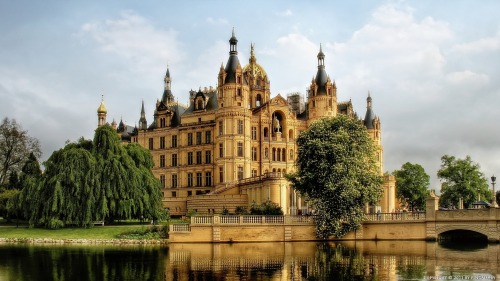
Schweriner Schloss is a castle located in the city of Schwerin, the capital of the Bundesland of Mecklenburg-Vorpommern, Germany. Under Duke Johann Albrecht I. (1525–1576), the castle saw some important changes. The fort became a castle, and the defensive functionality of the fortress was replaced with ornamentation and concessions to comfort. The use of terracotta during the Renaissance was dominant in North German architecture, and Schwerin's terracotta was supplied from Lübeck. For centuries it was the home of the dukes and grand dukes of Mecklenburg and later Mecklenburg-Schwerin. It currently serves as the seat of the state parliament. (wiki)
Hohenzollern Castle is a castle about 50 kilometers south of...
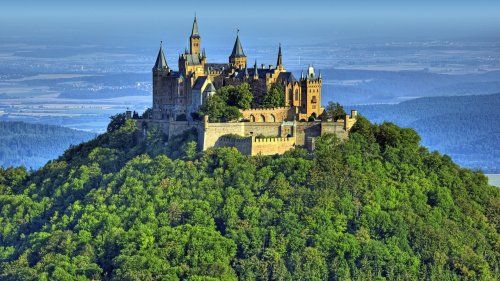
Hohenzollern Castle is a castle about 50 kilometers south of Stuttgart, Germany. It is considered the ancestral seat of the Hohenzollern family, which emerged in the Middle Ages and eventually became German Emperors. The castle is located on top of Berg Hohenzollern at an elevation of 855 meters (2,805 ft) above sea level, 234 m (768 ft) above surrounding Hechingen and nearby Bisingen to the south, both located at the foothills of the Schwäbische Alb. It was originally constructed in the first part of the 11th century. (wiki)
Chateau Saint-Jean de Beauregard is located 28 km from...
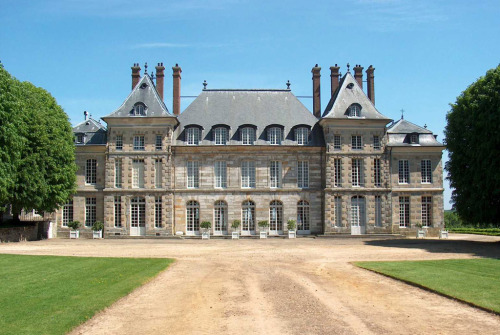
Chateau Saint-Jean de Beauregard is located 28 km from Paris in Hurepoix County and overlooks the Salmouille River. It was started in 1612 by François Dupoux, one the king's lawyers. At the end of the 18th century, the estate was bought by Mrs Charron , a general counselor's widow. She transformed the interior decoration of the house, which can be still be admired today. To this day, the entire estate remains a private property.
Blarney Castle is a medieval stronghold in Blarney, near Cork,...
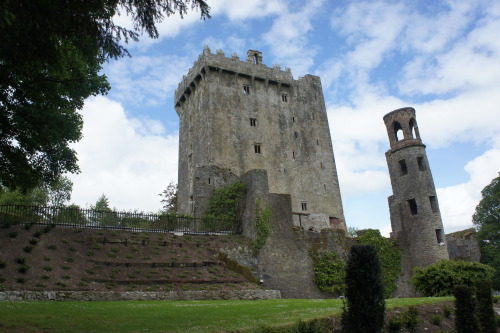
Blarney Castle is a medieval stronghold in Blarney, near Cork, Ireland, and the River Martin. The castle originally dates from before 1200, when a wooden structure was believed to have been built on the site, although no evidence remains of this. Around 1210 this was replaced by a stone fortification. It was destroyed in 1446, but subsequently rebuilt by Cormac Laidir MacCarthy, Lord of Muscry. The noted Blarney Stone is found among the machicolations of the castle. (wiki)
Chateau Fontainebleau, located 55 kilometres from the centre of...

Chateau Fontainebleau, located 55 kilometres from the centre of Paris, is one of the largest French royal châteaux. The palace as it is today is the work of many French monarchs, building on an early 16th century structure of Francis I. The building is arranged around a series of courtyards. The city of Fontainebleau has grown up around the remainder of the Forest of Fontainebleau, a former royal hunting park. (wiki)














No comments:
Post a Comment